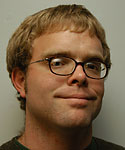By Phil Leckman
Arizona Daily Wildcat
Monday May 5, 2003
Though its cookie-cutter strip malls and far-flung gated communities may not reflect it, Southeastern Arizona is imbued with a long history. More than 10,000 years ago, ancient big-game hunters pursued mammoth and bison along the San Pedro River, not far from where the wildcat subdivisions of Sierra Vista now rise.
Tucson itself is no slouch in the history department, either. The founding of the Tucson Presidio by the Spanish in 1776 is often regarded as the city's beginning, but the fertile floodplains of the Santa Cruz River had already been home to settled farmers for 3,000 years ago by the time the first European priests and explorers began to arrive. The story of human life in this particular corner of the Southwest is a long one indeed.
If the facts just mentioned surprise you, you're probably not alone ÷ while Tucson can legitimately claim to be one of the longest continually inhabited spots in the U.S., this considerable history has largely been neglected by modern Tucsonans. Even the comparably recent remnants of the Old Pueblo's Spanish past are largely forgotten. With the exception of the famous mission church at San Xavier, most historic structures from Tucson's colonial past have long ago decayed to nothing.
 |
|
|
The San Agustin Mission, for instance, was one of Spanish Tucson's earliest structures, at the heart of the community's social and religious life. But the venerable 18th century adobe church was allowed to crumble into dust. By the 1950s, when the city bulldozed the mission's foundations to make way for a trash dump, nothing remained of the once-proud structure but low mounds and a few isolated stubs of mud-brick wall. And San Agustin is no isolated example. In the last 50 years alone, entire historic neighborhoods have fallen beneath the onslaught of the bulldozer, victims of a combination of indifference and deliberate destruction.
Fortunately for all Tucsonans, recognition of our city's long heritage is growing. Recent archaeological work along I-10 has revealed traces of Tucson's ancient inhabitants, substantially raising the profile of the Santa Cruz valley's earliest residents. A growing preservation movement is pushing hard to protect and restore those historic structures that still remain, and the Rio Nuevo development downtown will include a substantial segment devoted to Tucson history. Most promisingly, vigorous efforts are underway to begin educating Tucsonans about the city's past through public exhibits and programs, open houses at local archaeological digs, and outreaches to local schools.
I came across one exciting example of this push toward public education a few weeks ago while on my way to work in the archaeological research division of the Arizona State Museum. For the better part of a year, I'd noticed groups of elementary school children working on a variety of projects in the children's education section of the museum. But I hadn't paid much attention until the day I arrived at work and was greeted by a crowd of enthusiastic kids inviting me to the opening of the museum's latest exhibit.
The kids are Ellen Murphy's fourth grade class from Davis Bilingual Magnet School. The new exhibit is called "Cultural Currents/Corrientes Culturales: Tucson's Multicultural Heritage," and it is designed and curated by the students themselves, with guidance and assistance from the museum's education division. With a mix of artifacts from the museum's collections and their own displays and art projects, the kids have crafted an exhibit detailing Tucson's rich history from its earliest prehistoric beginnings to the present. As its name suggests, the exhibit details the lives and cultures of the Native Americans, Europeans, Chinese and others that the city's rich history weaves together like threads in a multicultural tapestry.
"Cultural Currents/Corrientes Culturales" will be open to the public at Arizona State Museum South this afternoon from 4 ÷ 6:30, and will feature student-led tours and a performance by Davis Magnet School's own mariachi ensemble, Las Aguilitas. Anyone with an interest in Tucson's history is encouraged to stop by ÷ it's an exciting story, particularly in the hands of enthusiastic, knowledgeable interpreters like Ms. Murphy's class. It's also a story that demonstrates how important Tucson's history is for the understanding of Tucson's present.
A world map at the entrance to the exhibit is marked with pushpins, showing where the ancestors of Ms. Murphy's class lived before finding their way to Tucson. Like the history they present, the class is a product of many cultures, with roots across far-flung countries and continents.
Their exhibit reminds us that the society we live in is the result of the contributions and dreams of people from all backgrounds ÷ all of us, regardless of ancestry, can take pride in playing a part in its genesis.

